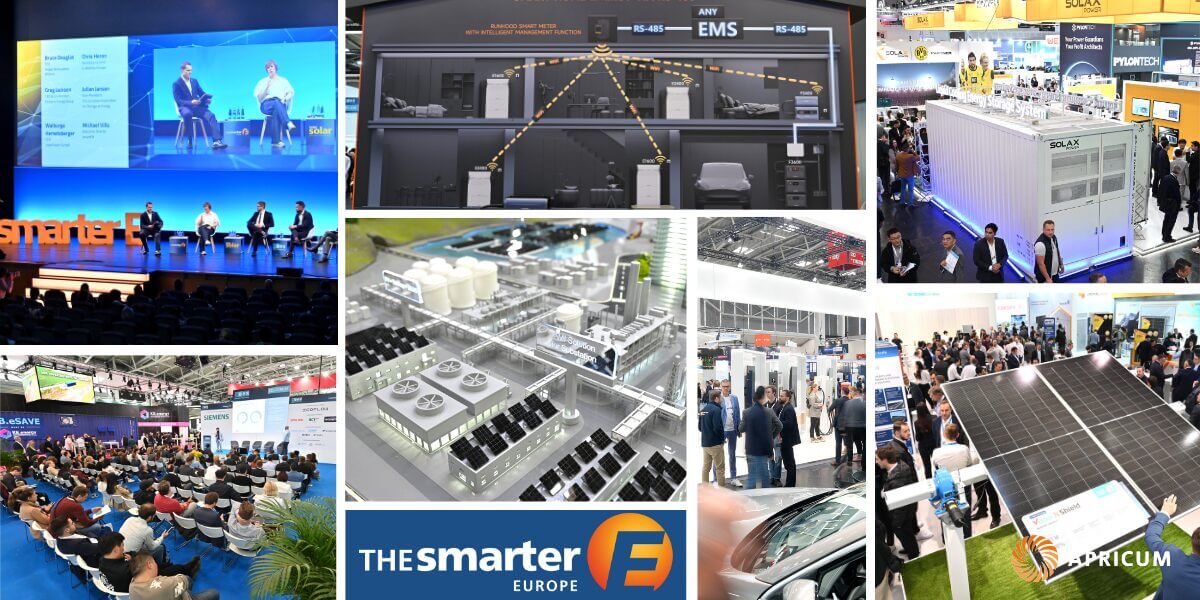After four bustling days of conference and exhibition, The Smarter E Europe, Europe’s premier energy industry platform, concluded earlier this month. The event spanned 19 exhibition halls and 200,000 square meters, with 2,737 exhibitors from 57 countries. The Apricum team joined 107,000 other industry professionals from 157 countries. Here are some key trends and themes we noticed across the event:
Despite demand, solar players might not be ready for utility-scale PV and BESS
We’re not the first ones to talk about this, but standalone utility-scale solar has rapidly become an unattractive investment. As renewable generation begins to saturate in Europe, negative electricity prices grow more common and PPA prices fall, co-locating or hybridizing BESS with renewables has become a more attractive option to increase revenue, avoid curtailment and fully utilize grid connections. Most of the downstream solar value chain isn’t ready for the complexity of BESS. A select group of market leading developers, asset managers and optimizers do have experience, but many solar-focused players may need an advisor to help them with the additional complexity of BESS before they get left behind.
Expansion indecision for PV mounting structure players
Many PV mounting structure players have delayed their growth plans to avoid the economic challenges that come from exposure to markets (e.g., the Netherlands) that are unattractive for standalone PV (due to saturation and increasingly frequent negative PV capture prices). Compounding these market conditions, regulatory uncertainties (e.g., Germany’s potential rework of subsidy schemes), provide an additional layer of complexity that is difficult to forecast. Players who can successfully find the best markets to enter and how to do it with expert help could gain a significant step up on their competition.
Growing digitalization
Everything at the exhibition is getting more digital, from the booths themselves to products and offerings. Players across the value chain, from manufacturers to distributors and developers, were eager to show off their growing digital capabilities. With the growing need for co-location at the utility-scale and comprehensive solutions for C&I and residential customers, more capable software and its seamless integration is becoming even more important.
The cycle of BESS cell and enclosure standardization
While the past couple of years have seen a standardization towards the 280/306/314 Ah briefcase BESS cell and 20’ container, we have started to see a divergence as modularity and logistics are becoming more important again. CATL, Hyperstrong and Fluence are among the names that have introduced new, differentiated BESS products, while cell manufacturers are beginning to offer larger cells (up to 1175 Ah!) that require different pack and system layouts. While the next couple of years are likely to lead to more differentiated hardware, Apricum expects the BESS industry to fall into a regular cycle of standardization and divergence as manufacturers standardize products to best meet market needs before differentiating to try and find the next standard.
C&I hardware is hot, but the market still demands comprehensive solutions
There were a lot of C&I products this year, but hardware has never been the challenge for C&I deployment. Customers need comprehensive solutions including fully integrated PV, BESS and demand-side assets as well as the software and optimization capabilities to ensure their energy bills decrease and the return on investment is worthwhile. This challenge is compounded by the heterogenous nature of the C&I customer landscape. Until cost effective and highly capable solutions are offered, Apricum doesn’t expect the C&I BESS market to take off, despite improved hardware.
HEMS strategy standardization is coming
We saw the early signs last year; Home energy management systems (HEMS) have become a battlefield for players from different sectors, including independent providers, energy infrastructure providers (e.g., Schneider Electric, Siemens) and heat pump manufacturers (e.g., Viessman). While different player archetypes still have separate strategies (independent providers are usually hardware agnostic, manufacturers focus on their own products), we may see more uniformity as installer acquisitions increase and the market saturates.
Sodium-ion BESS might be here sooner than expected
A greater number of Chinese cell manufacturers were offering sodium-ion cells and BESS this year, despite the Western consensus that sodium-ion will not be competitive with lithium-ion until the 2030s. But sodium-ion batteries are improving faster than expected, CATL expects its sodium-ion batteries expected to reach similar energy densities to LFP this year and Hithium has introduced a 20,000-cycle sodium-ion battery. With manufacturing scale increasing quickly, driven by their use in hybrid sodium-ion and LFP EV packs for fast charging capabilities, Apricum expects sodium-ion BESS to be economical sooner than you think.

